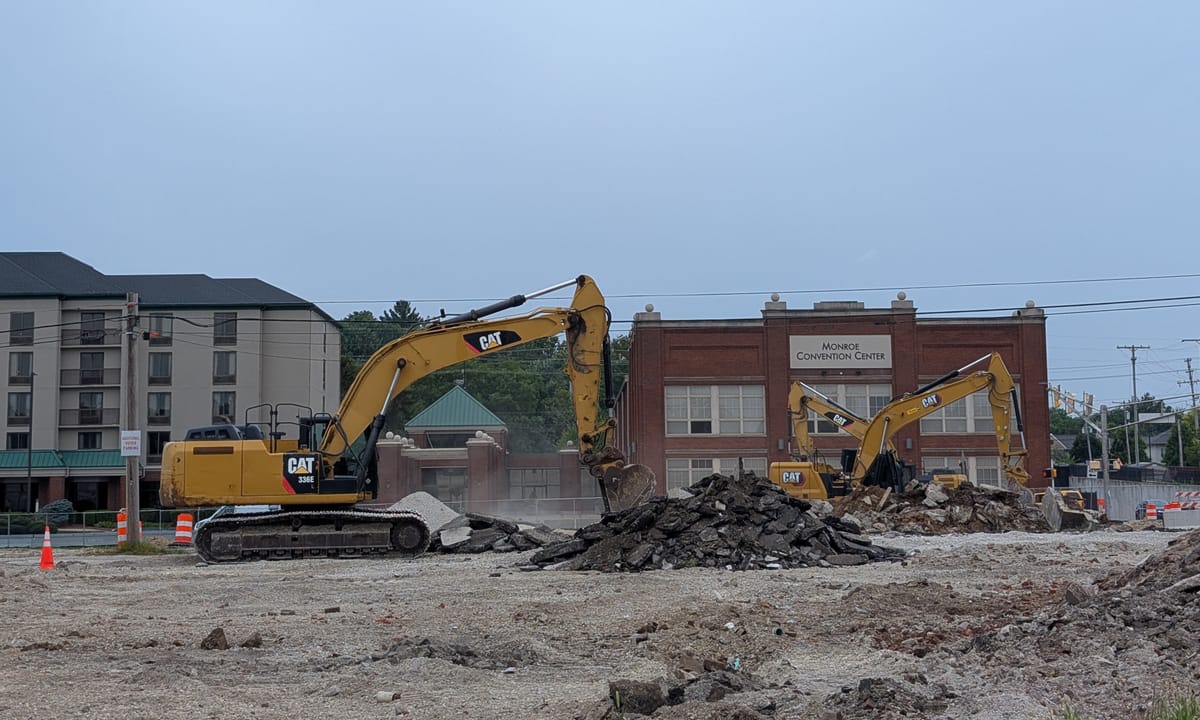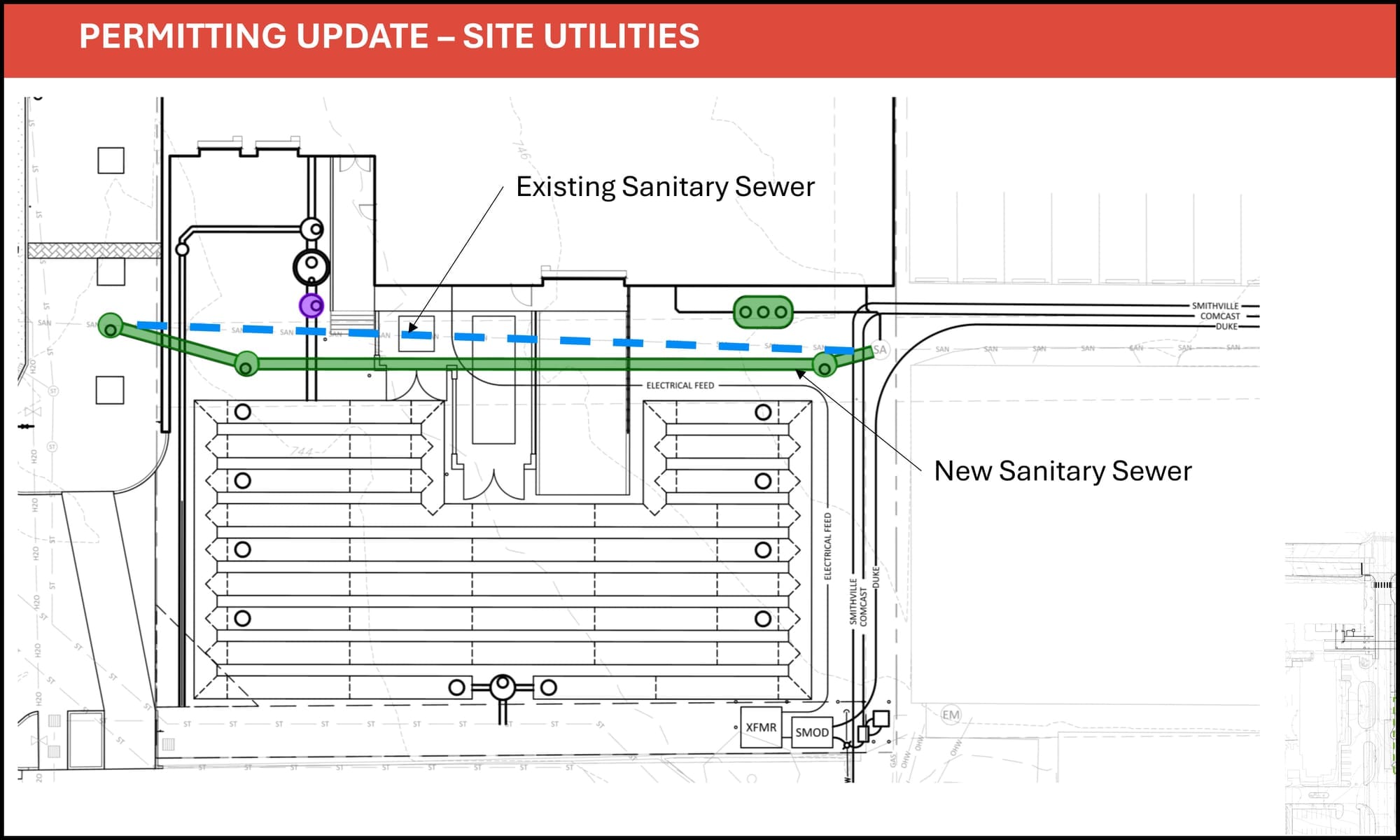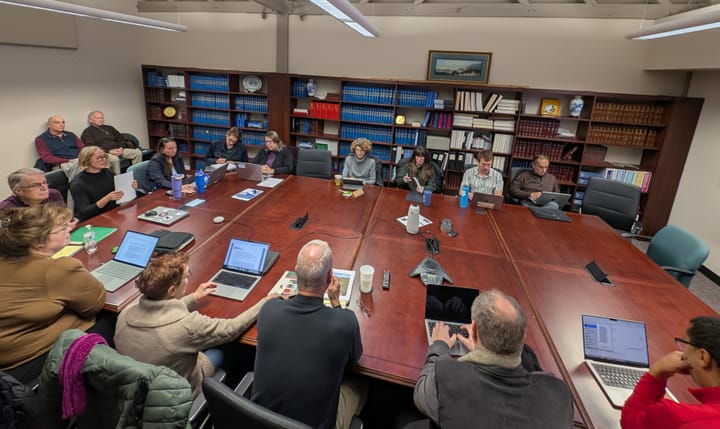Convention center construction bids OK’d under budget, but sewer standoff simmers with City of Bloomington Utilities
Monroe County’s CIB got good news about the final round of bids for the convention center expansion. The total for construction contracts landed under the $52-million budget. But Wednesday’s good news was tempered by a report about the status of sewer line negotiations between the CIB and CBU.



Left: Sanitary sewer diagram from the slide deck presented by Schmidt Associates to Monroe County's capital improvement board on June 18, 2025. Right: The view is looking west from Walnut Street across the construction site to the existing convention center. (Dave Askins, Aug. 4, 2025)
The start of construction activity for the expansion of the Bloomington Convention Center, south of 3rd Street, between College Avenue and Walnut Street, is now clearly visible as big excavators do the required digging.
For the construction work itself, at its meeting last Wednesday (July 30), Monroe County’s capital improvement board (CIB) got good news about the final round of bids, as recommended by its construction manager, Weddle Bros. Construction. The total of recommended awards for construction contracts landed at $50.9 million, under the $52-million budget.
But Wednesday’s news was tempered a bit by a report from CIB president John Whikehart, about the status of negotiations between the CIB and City of Bloomington Utilities (CBU). The two public agencies have been talking about moving and upsizing a sanitary sewer line that runs close to the southern edge of the planned new 60,000-square-foot building.
Whikehart indicated to his board colleagues that the back-and-forth between the CIB and CBU had led to an offer from CBU to pay only the difference in the cost of an 18-inch pipe compared to a 24-inch pipe, which he estimated at $5,000. Based on a response from CBU to a B Square question, the utility’s offer might include more than the just the differential cost of the pipe itself, but the dollar value of that offer is not settled.
The cost for the sanitary sewer relocation listed in the most recent tally from Weddle Bros.is pegged at $154,000. Whikehart said at Wednesday’s meeting there’s another $12,000 in design costs to be factored in.
Moving and upsizing the sewer pipe
According to CBU, the sewer pipe needs to be moved in any case, based on the planned design of the new building. The current pipe measures 18 inches. That’s under capacity for the amount of flow that will be coming from the west side of the city, according to CBU—that’s why the utility is looking to get the pipe upsized to 24 inches.
The convention center expansion project will be constructing a ramp, among other improvements, that will be placed on top of the sewer line. If the pipe has to be upsized after the convention center project is built and has started operation, the sewer project would completely shut down the convention center. That’s because there would be no access to the loading dock to the far west or to the kitchen.
At Wednesday’s meeting, Whikehart reprised some of the same sentiments that were expressed at a mid-June CIB meeting, when the sanitary sewer issue was surfaced. Whikehart said that from the CIB’s perspective, both the CIB and CBU stand to benefit from the relocation and upsizing of the sewer line, and that a cost-sharing arrangement should reflect that mutual benefit.
Whikehart told his CIB colleagues that while the CBU offered to reimburse only the estimated $5,000 difference in cost between 18-inch and 24-inch pipe, he had argued for broader relief, including the possibility of waiving $64,000 in sewer reconnection fees or sharing total project costs on a 75-25 basis. Whikehart said that because the CIB’s project would help the CBU avoid future expenses, a greater contribution from CBU was justified. However, he reported that the CBU’s attorney cited local code as a barrier to adjusting the fee structure, and after more discussion, the CBU reaffirmed its original offer, citing concerns about setting a precedent.
Whikehart then gave what he labeled as an “editorial comment,” which is not the CIB’s formal position, but based in part on his past experience serving on the city’s utilities service board. Whikehart said, “I know that on occasion an opportunity presented itself for updating an aging or undersized sewer line in a private development project.” He continued by contrasting private developers with the CIB, which cannot increase its budget or pass costs along to others.
Whikehart added, “A convention center does not make a profit. It generates economic benefit to the community.” Whikehart said that if considering anything more than its $5,000 offer for the difference in material cost set a precedent for future development, then it might be good public policy for CBU to consider setting the precedent that “sharing the expense of an infrastructure improvement now may save the rate payers full and potentially higher expense later.”
From the utility’s perspective, CBU director Kat Zaiger responded to an emailed B Square question, summarizing the situation like this: “CBU has agreed to pay the difference in cost between upsizing the sewer and relocating the existing 18” main that needed to be moved due to the site design of the convention center. The CIB is being asked to cover the cost of moving the location of the existing main to accommodate their site design …”
Zaiger’s message continued, “We have not yet been provided a firm cost difference from the CIB, but are more than happy to provide the difference in the cost for the larger main size and increased material and installation cost.” She added, “This could include the difference in soil removal, trenching materials, differences in manhole sizing, etc.” Zaiger put that in the context of CBU’s general policy on similar situations, writing: “This is CBU’s standard practice. Deviation from this standard would set a precedent for future developments that we would not be prepared to fund.”
Whikehart previously stated that for the sewer main move and upsizing, the CIB would not use money from the bond proceeds that are funding the convention center expansion project. Instead, the sewer costs would have to come out of the difference between the $70 million total project budget and the bond proceeds, possibly out of the “soft cost” budget.
Final round of construction contract awards
Approved by the CIB on Wednesday was the final round of awards for construction contracts for the convention center expansion project. Presenting the proposed awards was Josh Naugle of Weddle Bros., which is the firm serving as the construction manager for the project.
The total recommended award for the final round came in at $20,610,741. That brought the total of awarded contracts to $50.9 million, under the $52-million budget for construction. The total project budget is around $70 million.
The approved base bid awards include: $106,444 for landscaping (Sowders Landscaping); $737,000 for site concrete (Weddle Bros.); $3,018,890 for masonry (Hagerman); $4,350,000 for general trades (Weddle Bros.); $10,143,192 for plumbing and mechanical work (Harrell-Fish Inc.); and $551,550 for fire protection (Multicraft).
Weddle Bros. is allowed as construction manager to bid on packages and to “self-perform” some of the work. That’s why Weddle Bros. got the work for site concrete and general trades.
CIB member Adam Thies raised the question of whether three bidders for each package were required under the CIB’s contractual agreement with Weddle Bros. as construction manager. The answer was: There was no minimum number of bidders specified in the contract.
The second round of bidding for the awards that were approved last Wednesday stemmed from the fact that only one bid was received for those packages in the first round. The other packages, approved two weeks earlier by the CIB, all generated more than one bid. Thies said he was not criticizing Weddle Bros., but said, “Ultimately, we would have liked to see more bidders per package, particularly on the general trades, where [Weddle Bros. is] self-performing. A little competition of our own contractor would have been nice,” Thies added.
The use of union labor has been a topic of discussion for the convention center expansion project. Of the total awarded dollars across all packages, 86%—or just over $43.1 million—went to union contractors. The remaining 14%—about $6.8 million—was awarded to non-union (open shop) contractors. The share of dollars awarded to local contractors came to 64%—approximately $31.9 million—with the remaining 36% going to regional firms. Among the local contractors receiving awards were Weddle Bros., Harrell-Fish Inc., Sowders Landscaping, Multicraft, and Electric Plus.
With the major construction contracts for the convention center expansion now in place, attention will turn to some additional work that could be funded based on the bids that have been received.
The additional work is related to improvements to the existing convention center building. Those items, which include HVAC replacement, window upgrades, and new A/V infrastructure, total about $2.5 million and will remain under consideration by the CIB. But the guaranteed pricing periods for that extra work expire towards the fall.




Comments ()